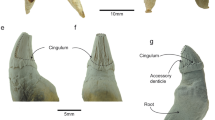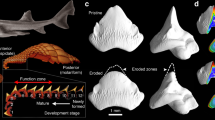Abstract
CONODONTS were small eel-shaped animals with vertebrate affinities1–4. Known almost exclusively from the small, tooth-like, phosphatic elements of their feeding apparatus, they have one of the finest fossil records of any group of organisms. Until recently the identity of the animal to which conodont elements belonged was one of palaeontology's great mysteries; the function of the elements themselves, particularly blade-shaped elements, remains uncertain (compare refs 3 and 4). But recent insights into the conodont skeletal Bauplan5 allow the debate over function to be taken beyond arguments of analogy. Here we present a functional analysis of opposed blade-shaped-element pairs as components of an integrated apparatus. From this we conclude that such elements operated as cutting teeth within a grasping and food-processing apparatus.
This is a preview of subscription content, access via your institution
Access options
Subscribe to this journal
Receive 51 print issues and online access
$199.00 per year
only $3.90 per issue
Buy this article
- Purchase on Springer Link
- Instant access to full article PDF
Prices may be subject to local taxes which are calculated during checkout
Similar content being viewed by others
References
Briggs, D. E. G., Clarkson, E. N. K. & Aldridge, R. J. Lethaia 16, 1–14 (1983).
Aldridge, R. J., Briggs, D. E. G., Clarkson, E. N. K. & Smith, M. P. Lethaia 19, 279–291 (1986).
Sansom, I. J., Smith, M. P., Armstrong, H. A. & Smith, M. M. Science 256, 1308–1311 (1992).
Briggs, D. E. G. Science 256, 1285–1286 (1992).
Aldridge, R. J., Smith, M. P., Norby, R. D. & Briggs, D. E. G. in Palaeobiology of Conodonts (ed. Aldridge, R. J.) 63–76 (Horwood, Chichester, 1987).
Lindström, M. Palaeontology 17, 729–744 (1974).
Jeppsson, L. Lethaia 12, 153–171 (1979).
Jeppsson, L. Lethaia 13, 228 (1980).
Conway Morris, S. Lethaia 13, 107–108 (1980).
Bengtson, S. Lethaia 13, 320 (1980).
Bengtson, S. Lethaia 16, 38 (1983).
Nicoll, R. S. BMR J. Aust. Geol. Geophys. 9, 133–147 (1985).
Nicoll, R. S. in Palaeobiology of Conodonts (ed. Aldridge, R. J.) 77–90 (Horwood, Chichester, 1987).
Jeppsson, L. Lethaia 4, 101–123 (1971).
Weddige, K. Cour. Forsch. Inst. Senckenberg 118, 563–589 (1990).
Norby, R. D. & Rexroad, C. B. Occ. Pap. Indiana geol. Surv. 50, 1–14 (1985).
Purnell, M. A. & von Bitter, P. H. J. Paleont. 66, 311–332 (1992).
Purnell, M. A. Progm Abstr. Can. Paleont. Conf. 1, 70 (1991).
Gould, S. J. & Lewontin, R. C. Proc. R. Soc. B205, 581–598 (1979).
Signor, P. W. Neues Jb. geol. paläont. Abh. 164, 59–63 (1982).
Fisher, D. C. Paleobiology 11, 120–138 (1985).
Aldridge, R. J. & Briggs, D. E. G. Nat. Hist. 5/89, 6–10 (1989).
Author information
Authors and Affiliations
Rights and permissions
About this article
Cite this article
Purnell, M., von Bitter, P. Blade-shaped conodont elements functioned as cutting teeth. Nature 359, 629–631 (1992). https://doi.org/10.1038/359629a0
Received:
Accepted:
Issue Date:
DOI: https://doi.org/10.1038/359629a0
This article is cited by
-
Zur Biologie, Taxonomie und Chronologie der Conodonten
Paläontologische Zeitschrift (1999)
-
Microwear on conodont elements and macrophagy in the first vertebrates
Nature (1995)
Comments
By submitting a comment you agree to abide by our Terms and Community Guidelines. If you find something abusive or that does not comply with our terms or guidelines please flag it as inappropriate.



